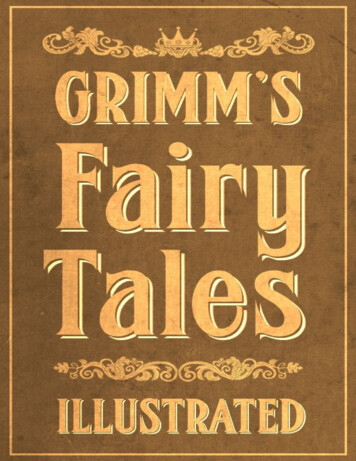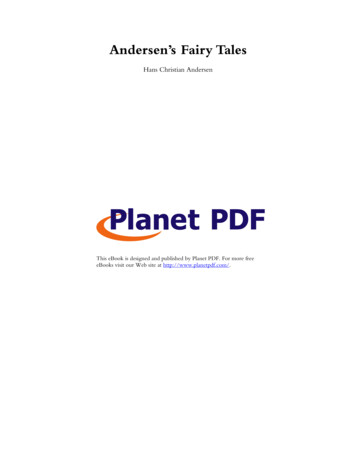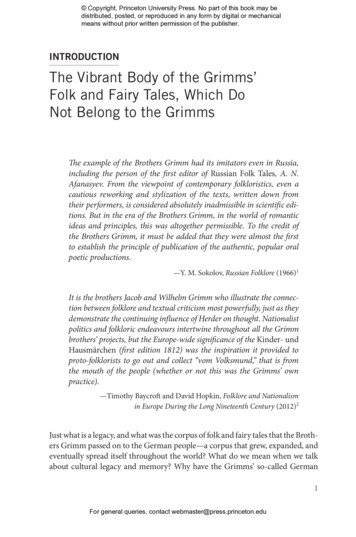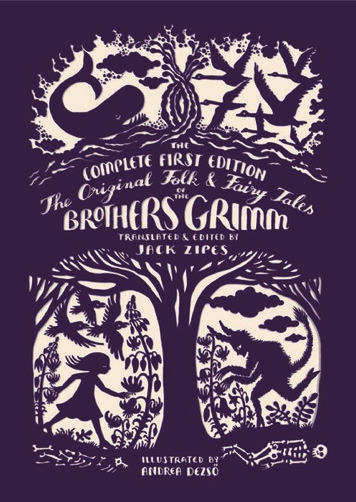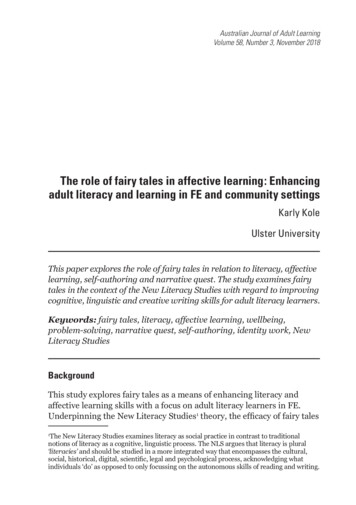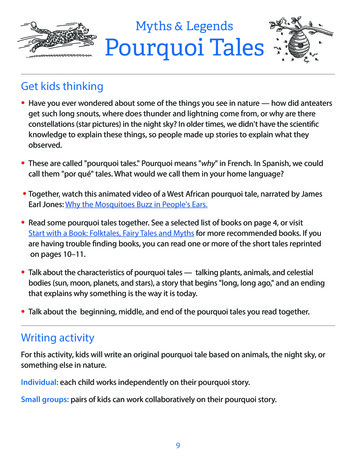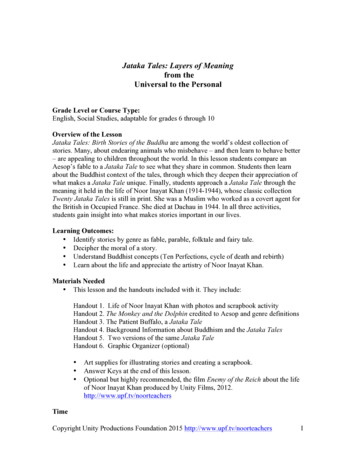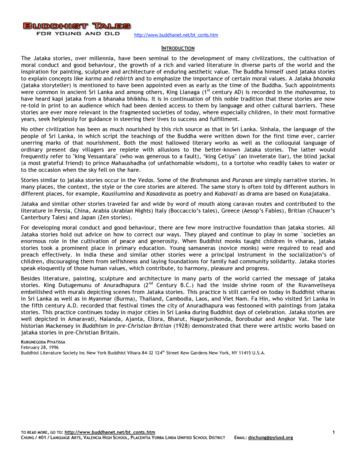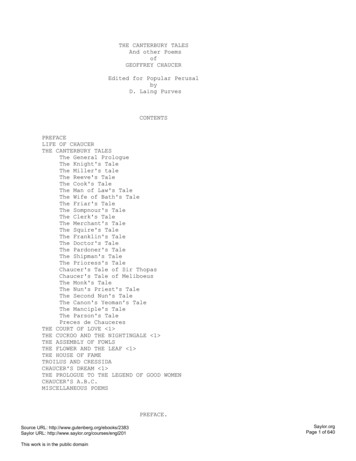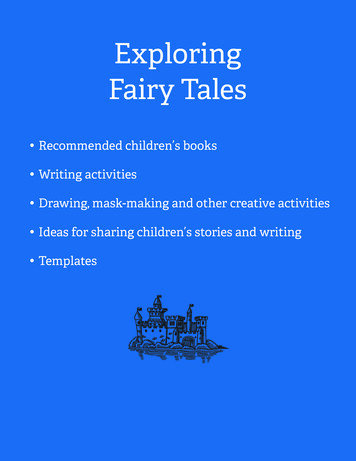
Transcription
ExploringFairy Tales Recommended childrenʹs books Writing activities Drawing, mask-making and other creative activities Ideas for sharing childrenʹs stories and writing Templates
Fairy TalesA fairy tale is a make-believe story with magical elements like spells, princes and princesses,dragons, trolls, fairy godmothers, talking animals, and witches. The characters may live inenchanted places.A common theme is good versus evil. Often, there is a characterwho is good and kind but is mistreated by a villain, such as awicked stepmother. There is also a heroic character who savesthe day by breaking a spell, tricking the villain, or performinga daring rescue.Characters in fairy tales will often have unusual names, like Rumpelstiltskin or Rapunzel.If the story begins with "Once upon a time," and ends with ". happily ever after," it isprobably a fairy tale!Fairy tales from around the worldBefore they were written down, fairy tales were oral stories, told or performed dramatically,and handed down from generation to generation. Fairy tales come from all over the world!Over time, people started to write down these ancient stories.In the 17th century, the Frenchman Charles Perrault publishedthe version of Cinderella we know today. In the 19th century,the Brothers Grimm collected German and European storiessuch as The Frog Prince, Hansel and Gretel, Rapunzel, SnowWhite, Rumpelstiltskin, and many others.In the 19th century in Sweden, Hans Christian Andersenbegan to write original fairy tales, including The LittleMermaid, The Ugly Duckling, The Snow Queen, The LittleMatch Girl, The Steadfast Tin Soldier, and The Wild Swans.The Arabian Nights, magical tales from the Middle East were first collected more than 500years ago! Familiar stories include Aladdin's Wonderful Lamp (originally a Chinese tale), AliBaba and the 40 Thieves, and the Seven Voyages of Sinbad the Sailor.1
Fairy TalesIntroduce kids to some fairy tales that may not be as well known, such as Abiyoyo (SouthAfrica), Strega Nona (Italy), Tim O'Toole and the Wee Folk (Ireland), Baba Yaga (Russia),Yeh Shen (the original Cinderella from China), and Momotarō, the Peach Boy (Japan),and The Tiger and the Brahmin (India).Discover more about fairy tales at Start with a Book, by browsing our booklists, kid-friendlywebsites, apps, and podcasts: Folktales, Fairy Tales and Myths.Get kids thinking Ask kids which fairy tales and fairy tale characters they can think of.What do they remember about the story? Read some fairy tales together. See a selected list of books on thenext page, or visit Start with a Book: Folktales, Fairy Tales and Mythsfor more recommended books. Talk about the characteristics of fairy tales — fantasy or make-believe, an enchantedsetting (castles, kingdoms, the forest), good versus evil, and magic, characters take onunusual forms (giants, witches, dwarfs, talking animals). There is usually a happy ending! Talk about the beginning, middle, and end of the fairy tales you read together. Try reading two different versions of the same story (like Lon Po Po and Little Red RidingHood) and talk about what’s the same and what’s different.Writing activitiesHere are three writing and creative activities to try after reading your fairy tales together: Mapping My Fairy Tale (see page 4) Fairy Tale Timeline (see page 10) Fairy Tale Catalog (see page 15)2
Fairy TalesSelected Childrenʹs BooksLittle Red Riding Hood Flossie and the Fox by Patricia McKissack, illustrations by Rachel Isadora (African American) Lon Po Po by Ed Young (China) Little Red Riding Hood: A Newfangled Prairie Tale by Lisa Campbell Ernst (American Midwest)The Princess and the Pea La Princesa and the Pea by Susan Middleton Elya (Latino) Princess and the Peas by Rachel Himes (South Carolina)Cinderella Cendrillon by Robert D. San Souci, illustrated by Brian Pinkney (Creole, Caribbean) The Korean Cinderella by Shirley Climo, illustrated by Ruth Heller (Korea) Mufaro's Beautiful Daughters by John Steptoe (Zimbabwe) The Gift of the Crocodile by Judy Siera, illustrated by Reynold Ruffins (Indonesia) The Rough-Face Girl by Rafe Martin, illustrated by David Shannon (Algonquin) Yeh Shen by Ai-Ling Louie, illustrated by Ed Young (China)Hansel and Gretel Hansel and Gretel by Rachael Isadora (Africa) Hansel and Gretel by Bethan Woollvin (modern retelling)Rapunzel Rapunzel by Rachael Isadora (Africa) Rapunzel's Revenge by Shannon Hale, illustrations by Nathan Hale (Wild West, graphic novel format) Sugar Cane by Patricia Storace (Caribbean)3
Fairy TalesSelected Childrenʹs BooksMore fairy tales from around the world Baba Yaga and Vasilisa the Brave by Marianna Mayer, illustrated by Kinuko Y. Craft (Russia) Peach Boy by Florence Sakade, illustrated by Yoshisuke Kurosaki (Japan) The Tiger and the Brahmin by Bran Gleeson, illustrated by Kurt Vargo (India) Tim O'Toole and the Wee Folk by Gerald McDermott (Ireland) The Wild Swans by Hans Christian Andersen, illustrated by Helen Crawford-White (Denmark)Fairy tale anthologies Grimm's Fairy Tales by Jacob and Wilhelm Grimm (Germany) Follow, Follow: A Book of Reverso Poems by Marilyn Singer, illustrations by Josée MasseAn Illustrated Treasury of Hans Christian Andersen's Fairy Tales by Hans Christian Andersen, illustrated byAnastasiya Archipova (Denmark) Mirror, Mirror: A Book of Reverso Poems by Marilyn Singer, illustrations by Josée Masse Princess Tales from Around the World by Grace Maccarone, illustrated by Gail de Marcken4
Fairy TalesSelected Childrenʹs BooksWhen the library is closedIs your public library closed? See if your public library offers OverDrive where you canborrow and read free ebooks, audiobooks, and magazines on your phone or tablet. All youneed is your library card to get access (and check out their Libby app for Android or iOSphones or tablets).There are also a number of online services that offer high-quality audiobooks and ebooks:Audible for Kids, Tales2Go, and Epic!.Here are some ways to explore fairy tales online: Folktales and Fairy Tales for All: audiobooks (Audible) Annotated Fairy Tales: fairy tale texts with history, list of similar tales across cultures,bibliography, illustration gallery, book gallery, and list of modern interpretations.(Sur La Lune Fairy Tales) The Emperor's New Clothes and Other Fairy Tales: animated videos (Geethanjali Kids) Famous Fairy Tales: animated videos (Little Cozy Nook) Fairy Tales from Around the World: historical and geographic adventure(Google Earth Voyager Story)5
Mapping My Fairy TaleFor this activity, kids will create an original full-color map based on a fairy tale you’veread together.Individual: each child chooses a fairy tale and works independently.Small groups (2-3 kids): each group chooses a fairy tale and works collaboratively.Supplies Pencils and art supplies: colored pencils, markers, crayons, paint. Colored constructionpaper (optional) Drawing paper or construction paper: 8-1/2 x 11 or larger. Or a roll of white paper orkraft paper Scotch tape, scissors School glue; masking tape or painters tape (optional)6
Mapping My Fairy TaleGet kids thinkingTalk about the settings in the fairy tales you read together. Use descriptive words like the“thick, dark woods” or the “shimmering castle”.Have each child choose a favorite fairy tale that creates a vivid picture about the world wherethe story takes place. Give kids time to imagine what that world looks like in their minds.Tell kids that they will be creating their own map that shows the fairy tale setting as they seeit. Ask kids to think about the elements they will want to include in the map.Let's get startedTape together two or more 8-1/2 x 11 sheets of paper tocreate a large space for the map. If you have a roll of whitepaper or kraft paper, cut two feet or more for each map.Here's a third option: create a "stand up" map by makinga 3- or 4-panel an accordion fold with your sheet of paper —see the diagram on the right. This works best with heavier construction paper.Although these fairy tale maps are imaginary, you can introduce kids to some of the basicelements of a real map. Kids can include these elements in their maps if they like: Title tells the viewer what this a map of. Compass Rose indicates North, South, East and West. Draw your own compass rose or useone of the graphics on page 9. Legend or key explains what the symbols on that map represent. For example, on theadventure map on the next page, you can see symbols for town, village, and dungeon. Scale: shows the relationship between a certain distance on the map and the actualdistance. For example, one inch might represent one mile. See the pirate map on thenext page.7
Mapping My Fairy Tale1 mile50 miles100 milesTell the kids to sketch out their maps in pencil first, and then finish it in colored pencil,crayon, marker, or paint. Kids can also use cut paper to create some of the elements on theirmaps. Remind the kids to think about their descriptive words as they create the elements intheir maps.Sharing our workWhen the maps are finished, tape them to the wall, and ask the kids to tell the fairy tale intheir own words while pointing out important places on their maps.Try this!Chalk Drawing: Instead of drawing their maps on paper, kids can draw them with sidewalkchalk outdoors. Each child can give a "walking tour" of their fairy tale map. Take a picture ofeach child with their map so there's a record of their efforts!Kids could also act out the fairy tale outside, and use their environment as the make-believesetting — shrubs and other plants (the forest!) steps or porches (the castle!), the sidewalk,boxes, or wagons (the ship!) .For more reading, writing, and learning resources, visit www.StartWithABook.org8
The Compass RoseDraw your own — or cut and glue one of these to your map9
Fairy Tale TimelineFor this activity, kids will create a beginning-middle-end illustrated timeline based on a fairytale you’ve read together.Individual: each child chooses a fairy tale and works independently.Small groups (2-3 kids): each group chooses a fairy tale and works collaboratively.Supplies Pencils and art supplies: colored pencils, markers, crayons, paint. Colored constructionpaper (optional) Option A: drawing paper or heavier construction paper: 8-1/2 x 11 (3-9 sheets pertimeline). Or a roll of white paper or kraft paper Option B: index cards: 6-9 per child or small group (or use the template on page 15).Yarn or string. Hole puncher or clothespins (optional) Scotch tape, scissors School glue; masking tape or painters tape (optional) Wooden dowels, 12-18 inches long (depending on the height of your paper) and 1/4-inchdiameter, two per map (optional)Get kids thinkingTalk about the fairy tale you read together. What happens in the beginning of the story? Inthe middle of the story? And what happens at the end? Give kids time to think about thesethree elements in each part of the story: the characters, the setting (time and place), and theaction.Tell kids that they will be creating their own illustrated timeline that tells the main parts ofthe story.10
Fairy Tale TimelineLet's get startedOption A: Give each child 3-9 sheets of paper depending on how detailed they want theirtimelines to be. For younger children, you can offer 3 sheets and suggest a basic beginningmiddle-end timeline.BeginningMiddleEndOlder kids may want to fill in more details (especially for the middle section of the fairy tale)and will want 6 or more sheets of paper.If you have a roll of white paper or kraft paper, cut 3-foot lengths or longer for children whowant to make very detailed timelines.Option B: Give each child 6-9 index cards (3 cards for younger kids). Tell kids to use the blankside of the card for their timeline, and to think of each card as an event on the timeline.Or, you can print and cutout the template cards from page 14.Illustrating the timelineHave the kids think about the characters, the time and place, and the action for eachsection of their timeline.The timeline should include words and pictures. The words can describe the time and place("A long time ago . in a kingdom by the Silver Sea" or "next Spring, out in the woods .") orthe characters ("The brave fisherman took his boat out to sea .").Now the kids can begin to work on their timeline. Suggest that they sketch out theirdrawings in pencil first, and then finish in colored pencil, crayon, marker, or paint. Kidscan also use cut paper to create some of the elements on their timelines.Assembling the timelineOption A: Tape the pieces of the timeline together on the backside. Be sure to get the piecesin the correct order! You may suggest to the kids that they write the number of each page orindex card on the back — 1, 2, 3, and so on.11
Fairy Tale TimelineLet's get started (continued)Option B: Use the hole puncher to make a hole on the top right and left corners of theindex card. Then cut a length of yarn or string and have the kids weave it through theholes to create a line of cards, like in the example below. You could alternatively useclothespins to attach the cards to the yarn or string.Copyright The Owl TeacherWhen the timelines are finished, tape them to the wall, and ask the kids to tell the fairy talein their own words while pointing out important events and action on their timelines.Try this!Scroll Timeline: Cut the wooden dowels to the right length — about 4 inches taller than theheight of each child's timeline. Have the kids attach the dowels to the right and left sidesof the paper with glue or tape. Roll up the timeline into a cylinder, like a Torah or Japanesescroll. (If you use glue to attach the dowels, be sure it is dry before you roll the paper.) Kidscan dramatically unroll their timeline to share with family and friends — you might evenneed a helper to hold one side of the timeline as you unroll.12Copyright The Owl Teacher
Fairy Tale TimelineMask makingStorytellers and actors from all over the world have usedmasks for thousands of years to help tell their stories.Invite kids to make masks of the characters from theirfairy tales. You can use ordinary household items orrecyclable materials, or make one with papier maché.Find directions at the links below: Milk jugs Cardboard Egg cartons Paper plates Paper bags Papier machéPhoto Warren KingSharing our workWhen the timelines are finished, tape them to the wall, and ask the kids to tell their fairy talein their own words while pointing out important places on their timelines.For more reading, writing, and learning resources, visit www.StartWithABook.org13
Fairy Tale Timeline Template14
Fairy Tale CatalogFor this activity, kids will create an illustrated catalog of items from multicultural fairy talesyou’ve read together.Individual: each child creates his or her own fairy tale catalog.Small groups: each group works collaboratively on their fairy tale catalog.Supplies Pencils and art supplies: colored pencils, markers, crayons, paint. Construction paper: white and colors Decorative items: pom poms, glitter, gold leaf paper, sequins, buttons, etc. (optional) School glue Stapler Hole puncher, yarn (optional)Get kids thinkingIf you can, read a variety of fairy tales from different parts of the world. See the list ofrecommended books on pages 3-4 for ideas. Talk about the stories you've read together.Many of them are full of incredible objects with magical powers like an enchanted mirror.Other objects might not be magical but they have an important role in the fairy tale —think about Little Red Riding Hood's cape!What if there was a catalog where you could browse many of the wondrous items you'veheard about in fairy tales from around the world? If kids are not familiar with catalogs, adultscan show examples of print catalogs or online stores.Tell kids that they will be creating their own illustrated catalog of fairy tale objects. They willbe practicing their descriptive writing skills. Descriptive writing helps readers create a clearpicture in their minds of a person, place, thing, or event. Strong descriptive writing uses oneor more of the 5 senses: sight, smell, taste, touch, or sound.15
Fairy Tale CatalogLet's get startedHave the kids brainstorm ideas for the objects to include in their catalogs — it could be glassslippers, golden ball, magic harp, flying carpets, or seven-league boots, or .?Kids can do this independently and jot down ideas on their own sheet of paper, or an adultcan lead the discussion and write all the ideas on a flip chart or poster paper. Be sure toidentify which fairy tale the object comes from.Ask the kids: do you see different kinds of objects in fairy tales that come from differentcultures and different parts of the world? Be sure to include some of these in your fairy talecatalog.Writing the descriptionsThe next step is to get the kids writing vivid descriptions of the objects in their catalogs.Ask the kids to select their fairy tale objects, and to use one sheet of paper (or a half-sheet)for each object in their catalogs.Have the kids to write down their descriptions of each object in great detail, using colorfuldescriptive words. Younger kids who aren't yet writing can dictate their ideas to an adult.The following questions can help spark ideas: What does it feel like to touch? Smooth, rough, sharp, bumpy, squishy? Does it have a unique smell? What color or colors? Does it shine or sparkle? What materials is it made of? Cloth, jewels, bronze, iron, stone? Does it make a sound when you touch it? A clang, a rustle, musical notes? What is your object used for? How does it work?Next, the kids will illustrate their objects, using crayons, colored pencils, or paint. If you havedecorative materials on hand (such as pom poms, glitter, gold leaf paper, sequins, or buttons),children can glue these on to create a collage.This is a project you can keep adding to until you're ready to bind your pages together!16
Fairy Tale CatalogLet's get started (continued)Assembling the catalogsOnce each child or group has finished all of their descriptive illustrated pages, it's time to adda cover and bind the pages into a booklet.Catalog covers: Kids can create their own cover art, or use one of the decorative templatesprovided after page 18 in this packet.Show the kids how to assemble their pages in the order they want and then insert the pagesbetween the front and back cover. The simplest way to bind the catalogs is to staple alongthe left-hand side of the booklet.To cover the staples, kids can place a piece of decorative tape along the stapled edge sothat half of the tape is on the front of the booklet; press down on the tape, and then foldthe other half of the tape towards the back and press down again.For a fancier binding, show the kids how to punch holes through all layers of their bookletson the left-hand side. Then, demonstrate how to thread the yarn through the holes and tieit off. (Tip: roll a small piece of tape around one end of the yarn to make it easier to threadthe holes.)Copyright The Hungry Artist17
Fairy Tale CatalogSharing our workWhen the fairy tale catalogs are finished, gather the kids together in a circle and pass thebooklet around. Give each child a chance to talk about their object and for the other kids toask questions.Try this!That Will Cost You 10 Magic Beans: It's a catalog, so fairy tale characters might want to buya new flying carpet or glass slipper. Have kids include in their catalogs the store where thecustomer can buy it (and who the store owner is) and the price for each item— 3 gold pieces,10 magic beans, etc.I Saw It on TV: Kids can make up television ads for the magical items they are selling and actout their sales pitch for friends and family. Older kids could work together to develop andperform episodes from The Fairy Tale Shopping Network.For more reading, writing, and learning resources, visit www.StartWithABook.org18
TheFairy TaleCatalogBy:
By:TheFairy TaleCatalog
TheFairy TaleCatalogBy:
By:TheFairy TaleCatalog
the Brothers Grimm collected German and European stories such as The Frog Prince, Hansel and Gretel, Rapunzel, Snow White, Rumpelstiltskin, and many others. In the 19th century in Sweden, Hans Christian Andersen began to write original fairy tales, including The Litt
